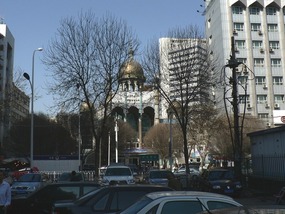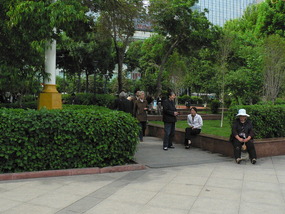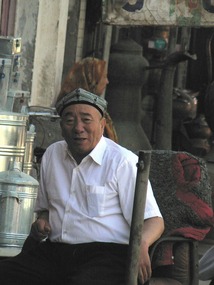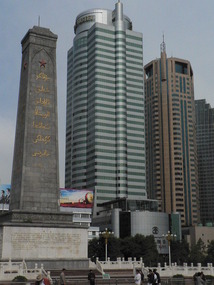It is always good to be back in Urumqi, the capital city of the far western Province of Xinjiang. We have used the city for our last three trips to China as a convenient base for our travels into Central Asia and Pakistan. We are now of course very familiar with Urumqi which always feels like home.
Our China Eastern Airlines flight from Shanghai to Urumqi was mildly disappointing in that the cabin staff insisted all the window shutters be closed for a lot of the journey. We have travelled this five hour flight many times and one of the nicer parts of the journey is to look down on the fascinating mountain and desert landscapes of the provinces of Shaanxi, Gansu and Xinjiang.
The glimpses we did see were still worthwhile. From Shanghai to Shaanxi tiny terraced farms clung impossibly to steep mountain slopes. Resembling upturned molars, every mountain crevice was filled by lush green farm plots. It was of course the Spring season. Huge deserts swallow a lot of Shaanxi Province and soon the land transformed into large expanses of buff treeless plains intercepted by strangely contoured bare mountains. We were puzzled by what looked to be huge dry river beds, their extensive tributaries contorted and entangled like a mass of riddled tree roots. We assume these are snow fed river beds that become alive, flooding the bare plains during the warmer weather. Closer to Urumqi, our trip took us over the snow powdered Tian Shan Mountains. Although we were travelling later this trip, there was a lot less snow around than what we have seen in other years.
Urumqi is a city of some 1.5 million people. Having the dubious reputation of being the furthermost city in the world from a coast line, it is located in a formidably cold and hostile environment surrounded by the magnificent snow capped Tian Shan Mountain Range.
Airport settings are never a good welcome to any city. Despite its pretty mountain backdrop, the sprawling outskirts of Urumqi are depressing. Collective farms with central cement block housing resembling concentration camps are located next door to large industrial areas and their belching chimney stacks, coal mines and poverty stricken housing. It is a formidable environment.
Conversely, the city centre is thriving and prosperous. The parks are green, manicured and covered with flowering petunias, and the streets clean and well maintained.
Urumqi is a fascinating melting pot of Uighur and Han Chinese peoples and modern sky scraper buildings sit oddly side by side with mosques, old city housing and fabulous bazaars. The most striking feature of Urumqi, and of other cities in the far west of China, is that most of the people no longer look at all Chinese. They are of course not Chinese but are mostly of the minority Uighur group. And indeed, the Uighur people do not regard their part of the world as China but as their native East Turkestan. The local Uighur people are Central Asian both in appearance and culture, are of medium to large build with dark complexions and broad friendly faces. Veiled Uighur women, elegantly dressed in beautiful and bright long flowing gowns and men wearing traditional pointed pill box style hats walk the streets next to young modern people in expensive designer outfits or jeans and T shirts. Interestingly, we have seen very few fully veiled women in Urumqi.
In central Urumqi, Buiks, Lincolns, Mercedes and a huge array of large four wheel drive cars reveal a prosperity enjoyed by the wealthier inhabitants of Urumqi, the Han Chinese. In fact it is staggering to see the number of extremely expensive cars and the number of designer wear shops and huge cosmetic and perfume sectors of the Urumqi department stores. This part of Urumqi is in stark contrast to the abject poverty we saw on the outskirts of the city during our first visit to Urumqi by bus from Turpan in 2007.
We arrived at Urumqi airport in the mid afternoon of a stiflingly hot and windy day. Our taxi driver refused to switch on his meter and despite our protestations of the steep price he charged us - which was about double what we expected to pay - we shrugged our shoulders and paid him*.
We always stay at the Hoi Tak Hotel in Urumqi. It has a five star rating, a great restaurant and is conveniently located in the centre of the city just opposite the lovely Renmin Park and the Tian Shan department store and supermarket. This time the hotel looked in need of major renovations. Even though our room was one of the best, overlooking Renmin Park and with wonderful views to the Tian Shan, the carpets were filthy and the furniture was shabby and threadbare. The most disappointing feature, however, was that there was no air conditioning. Well, that is there was no cooling as the air conditioners for the entire hotel were still switched over to winter heating. Apparently, this was an unusually warm Spring but it did not add to our humour. Opening the windows was the only option. You could easily just walk out of the huge windows onto a 30 floor drop to the road. China has not yet caught up with the Occupational Health and Safety Standards of European countries. Anyway, the cool evening air from the Tian Shan Mountains did the job and was much appreciated.
The next morning we walked to the now very familiar Erdaoqiao Markets, some four kilometers from our hotel. These markets are always tempting but as it was so early on in our travels we decided to postpone any purchases until we returned in late May. A very good decision as it turned out....
* We later found out that taxi drivers must pay fees to enter and park in the airport grounds. The longer they stay waiting for passengers, the more fees they are charged. This accounts for the difference in taxi fares travelling to and from Urumqi airport. We were pleased as we had always found Chinese people to be absolutely honest.

 Urumqi, Xinjiang Uygur, China
Urumqi, Xinjiang Uygur, China








2025-05-22